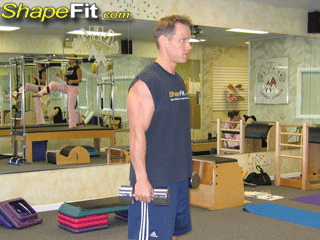Muscles Targeted: Alternating dumbbell curls are excellent for adding size and strength to your biceps and for overall arm development. This exercise primarily targets the biceps and also engages the anterior deltoids and the trapezius muscles for stabilization. This exercise not only stimulates your biceps, but also the forearms as a secondary muscle. When performed with proper technique and strict form in conjunction with a good balanced diet, alternating dumbbell curls will help you achieve your goals of adding size to your arms.


%CODE170%
Exercise Instructions: You can perform this exercise by either standing or sitting on a bench, whichever you prefer. Grab a dumbbell in each hand and let your arms hang naturally at your sides. Slowly curl the dumbbell in your right hand up trying to touch it to your shoulder. While you are performing the movement, turn (i.e., supinate) your palm outward and squeeze your bicep for a one-count at the top of the movement. Slowly lower the dumbbell to the starting position and repeat with your other arm.
Why This Exercise is Important: Alternating dumbbell curls help to correct any strength and size imbalances in the biceps as it works each arm individually. In this exercise, the biceps muscles are constantly put under tension. When the arm is lowering the dumbbell down (eccentric portion), it is still contracted isometrically and thus leads to a unilateral dynamic movement of the muscles. Alternating dumbbell curls allow you to isolate the biceps in each arm by letting you concentrate on the movement of each arm individually. It offers the full advantage of a mind and muscle connection with each arm and they get additional time to rest between curls as compared to working both arms in unison (barbell curls).
Things To Avoid: This exercise must be performed with strict form at all times. You should not allow your wrists to hinge or bend too far up or down while lifting the weight. The wrist must be aligned with the forearm throughout the movement while performing this exercise. To maintain constant tension in the muscle, avoid jerky or fast movements and do not rest the dumbbell on your shoulder at the top of the movement or drop them back down too fast while lowering the weight. Your body must be kept stable throughout the set while avoiding any type of swinging or leaning back as you raise the weight up. Careful attention must also be given to maintain a proper breathing pattern throughout the set. You should exhale while you curl the weight up and then inhale as you lower the dumbbell down.
Reps and Sets: The exercise must always begin with a warm-up set using light weights for 15-20 repetitions. Warming up helps to get blood into the muscle which will help your body get ready for heavier resistance and also avoid any issues that would otherwise induce injury to the muscles if they are exposed to heavy training without warming up. Following the warm-up set, you will do 2-3 working sets of alternating dumbbell curls with 10-12 repetitions per set for the best results. Use appropriate weight in the first set to complete the full 12 repetitions ensuring the last few repetitions are very demanding. For each of the following sets, a proportionate increase in the weights can be implemented making the last few repetitions of the set difficult to complete. In order to track your progress periodically, the weights can be increased to higher levels once you can comfortably complete three sets of 12 full repetitions.
You must give adequate rest to the muscle after each set ranging between 90-120 seconds to enable the muscle to recover properly. Since biceps are a smaller muscle group they must not be overworked with too many sets in order to avoid overtraining which could result in halting the growth of the muscle. Hit the biceps with a maximum of 6-8 total sets and then let your muscles rest and grow. You should only train your biceps once per week for the best results. Remember, your biceps will also get stimulated when you train back (pulling exercises), so you really don’t need to overload the biceps with too many exercises on your arm training day.
Other Exercises To Use: Alternating dumbbell curls can be combined with incline dumbbell curls, preacher curls and hammer dumbbell curls to create an effective workout routine for your biceps. When doing this many exercises (3-4) in a workout, shoot for only 1-2 sets per exercise. Choosing the right combination of exercises is crucial for achieving peak performance and facilitating overall muscular development. View our extensive database of exercise guides for a comprehensive list of exercises that target the biceps.




